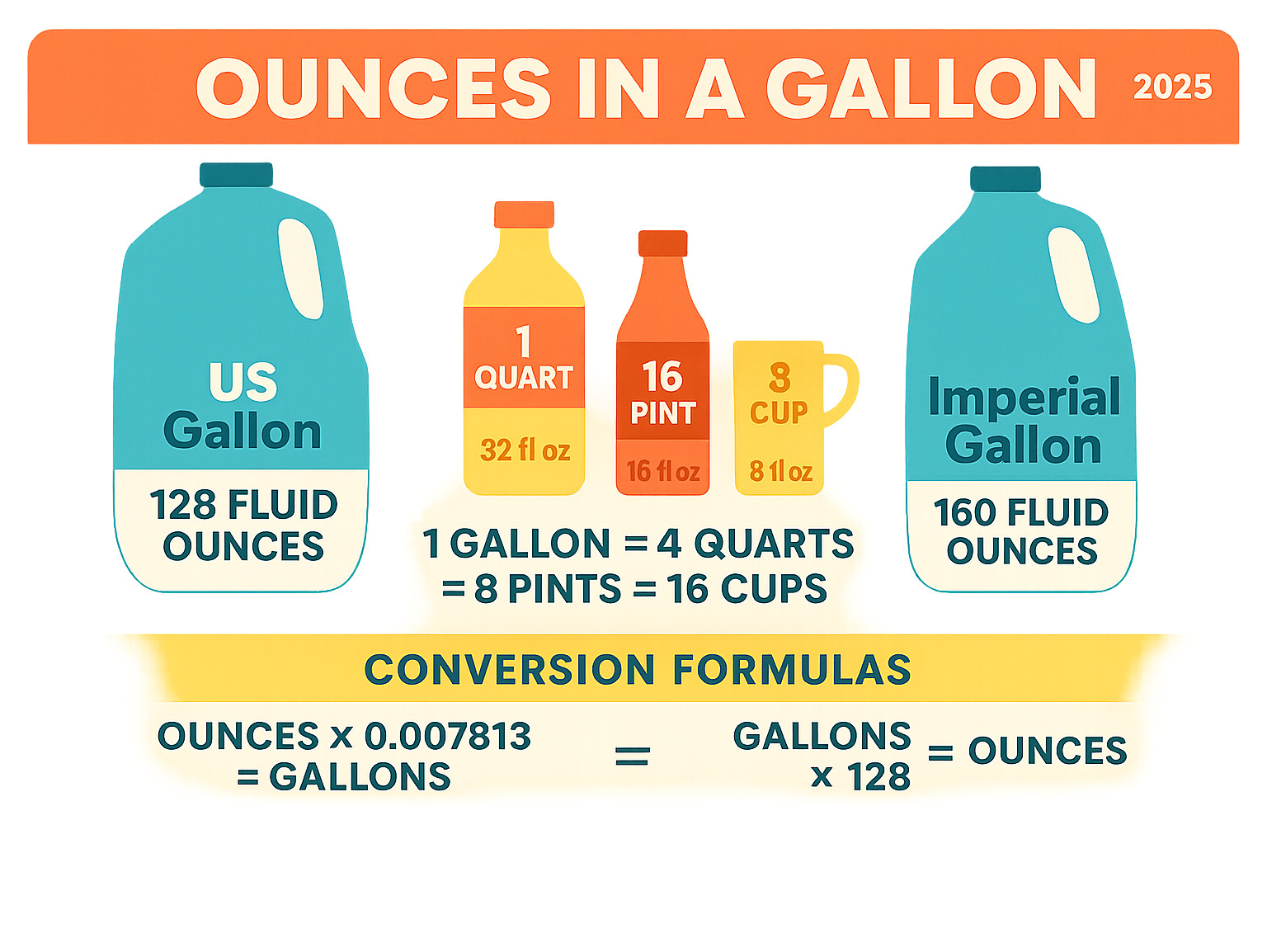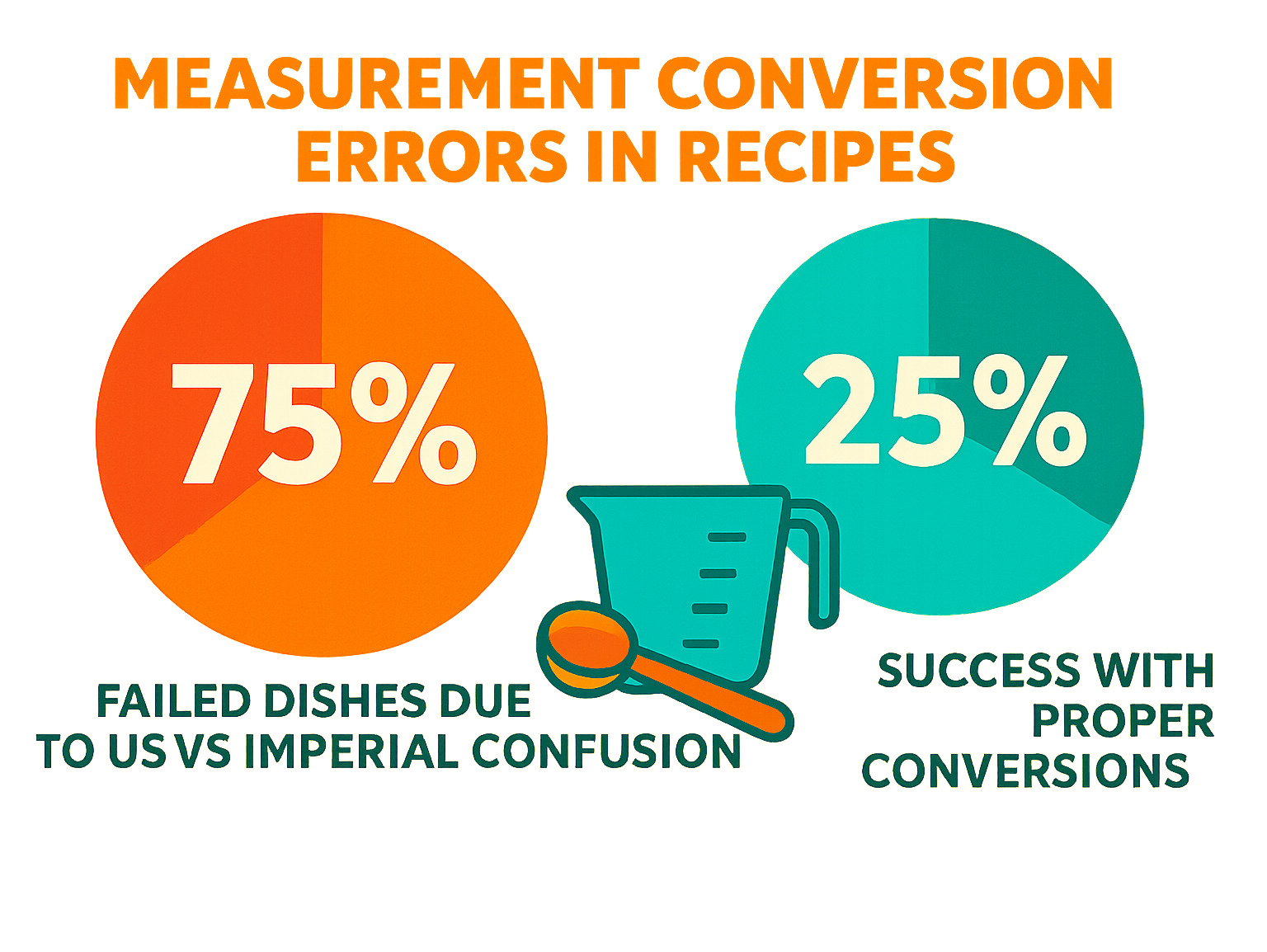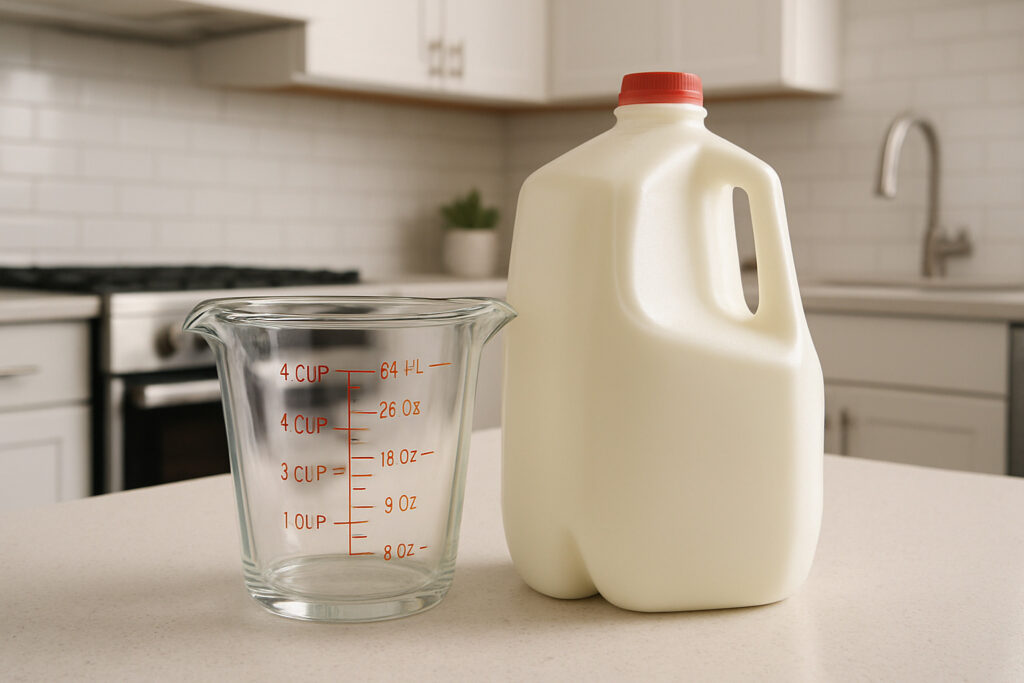Why Knowing Ounces in a Gallon Matters for Every Kitchen
Understanding ounces in a gallon is essential for accurate cooking, proper hydration tracking, and successful recipe scaling. Whether you’re following a recipe from abroad or calculating your daily water intake, getting these conversions right can make or break your culinary trips.
Quick Answer:
- US System: 1 gallon = 128 fluid ounces
- Imperial System: 1 gallon = 160 fluid ounces
- Half gallon: 64 fluid ounces (US)
- Quarter gallon: 32 fluid ounces (US)
As one cooking enthusiast noted in their research: “Have you ever found yourself in the middle of a recipe, needing to measure out an ingredient in ounces, but the recipe calls for gallons? It can be confusing and frustrating but don’t worry, you’re not alone!”
This confusion stems from the fact that different measurement systems exist worldwide. The US uses a different gallon size than the UK, and understanding these differences becomes crucial when you’re exploring authentic recipes from various cultures during your culinary travels.
Why This Matters for Food Lovers:
- Recipe accuracy depends on precise volume measurements
- International recipes often use different measurement systems
- Proper hydration requires understanding fluid ounce conversions
- Scaling recipes for dinner parties needs exact calculations
- Food service and home brewing rely on consistent measurements
The distinction between fluid ounces (volume) and dry ounces (weight) adds another layer of complexity that every serious cook should master.

Ounces in a Gallon 101
When you’re standing in your kitchen wondering how many ounces in a gallon you’re dealing with, the answer isn’t as straightforward as you might think. It’s like asking “how long is a piece of string?” – it depends on which piece of string you’re measuring!
The magic number for most American cooks is 128 fluid ounces in one US gallon. This is the measurement you’ll encounter in virtually every American recipe, from your grandmother’s soup to that trendy restaurant copycat dish you found online.
But here’s where things get interesting – if you’re following a recipe from across the pond, you’re dealing with the Imperial gallon, which contains 160 fluid ounces. That’s a whopping 32-ounce difference! Imagine the disaster if you’re scaling up a British pudding recipe for a dinner party and get this wrong.
Understanding the Different Types of Gallons
Most home cooks only need to worry about wet gallons (for liquids), but there’s also something called a US dry gallon that equals about 4.40 liters. You’ll rarely encounter this unless you’re buying grain in bulk or working in agriculture.
The building blocks of these measurements are fluid ounces themselves. A US fluid ounce measures 29.57 milliliters, while an Imperial fluid ounce is slightly smaller at 28.41 milliliters. These tiny differences add up quickly when you’re working with gallon-sized quantities.
Wet vs Dry: A Crucial Kitchen Distinction
Here’s where many home cooks get confused – and rightfully so! Fluid ounces measure volume (how much space something takes up), while dry ounces measure weight (how heavy something is).
Think of it this way: a cup of feathers and a cup of rocks both take up the same volume, but they definitely don’t weigh the same. This density factor becomes crucial when you’re baking, where precision can make the difference between a fluffy cake and a dense brick.
The avoirdupois ounce (that’s just a fancy name for the regular weight ounce we use) equals 28.35 grams. But remember – you can’t directly convert between fluid ounces and weight ounces without knowing what you’re measuring.
| Measurement System | Gallon to Fluid Ounces | Gallon to Liters | Fluid Ounce to mL |
|---|---|---|---|
| US Customary | 1 gal = 128 fl oz | 1 gal = 3.785 L | 1 fl oz = 29.57 mL |
| Imperial (UK) | 1 gal = 160 fl oz | 1 gal = 4.546 L | 1 fl oz = 28.41 mL |
Unit Abbreviations That’ll Save You Time
When you see “gal” in a recipe, that’s gallon. “Fl oz” means fluid ounces, while plain “oz” typically refers to weight. If you’re dealing with metric measurements, “L” is liters and “mL” is milliliters.
Why the Numbers Differ: US vs Imperial
The story behind these different measurement systems is actually pretty fascinating. When American colonists were establishing their own standards, they started with the British Imperial system but then went their own way – kind of like a culinary declaration of independence!
Meanwhile, Britain kept tinkering with their measurements too. The result? A US gallon equals 3.785 liters, while an Imperial gallon measures 4.546 liters – that’s about a 20% difference that can absolutely ruin your recipe if you’re not paying attention.
This legacy from our colonial past means that today, when you’re exploring authentic British recipes or trying to recreate that amazing dish you had in London, you need to be extra careful about which measurement system you’re using.
Fluid vs Dry Ounces in a Gallon
This is where baking precision becomes absolutely critical. Fluid ounces measure volume, while dry ounces measure weight – and they’re not interchangeable without considering what you’re actually measuring.
Eight fluid ounces of water weighs about 8 ounces because water has a density close to 1. But 8 fluid ounces of honey? That’s going to weigh significantly more because honey is much denser than water. This density factor is why serious bakers often prefer weighing their ingredients rather than measuring by volume.
When you’re working with ounces in a gallon conversions, always double-check whether you’re dealing with fluid measurements (volume) or weight measurements, especially when scaling recipes up or down.
History of the Gallon & Ounce
The word “ounce” comes from the Roman “uncia,” which originally meant one-twelfth of a copper bar. It’s amazing how these ancient measurements still influence our modern kitchens!
The gallon has an even more colorful history. During medieval times, there wasn’t just one gallon – there was an “ale gallon” for beer and a “wine gallon” for wine. Imagine the confusion at medieval markets! Different regions had their own standards, creating chaos that lasted for centuries.
It wasn’t until various standardization acts in the 18th and 19th centuries that governments finally said “enough is enough” and established the relatively consistent measurements we use today. Thank goodness – can you imagine trying to follow a recipe if every town had its own version of a gallon?
Converting Like a Pro: From Gallons to Ounces (and Back)
Once you understand the basic ounces in a gallon relationship, converting between these measurements becomes second nature. The key is memorizing a few simple formulas and having reliable reference points at your fingertips.
The math is actually quite straightforward. For US measurements, you’ll multiply by 128 to go from gallons to fluid ounces, or divide by 128 to go the other direction. So if you’re scaling up that amazing soup recipe for a dinner party, just remember that one gallon gives you 128 fluid ounces to work with.
Imperial measurements follow the same logic but use 160 as your magic number. This becomes especially important when you’re exploring authentic British recipes or following cooking instructions from UK-based food shows.
Making Metric Connections
Converting to metric measurements opens up a world of international recipes. One US gallon equals 3,785.41 milliliters, while an Imperial gallon measures 4,546 milliliters. When you’re working with liters, simply multiply US gallons by 3.785 or Imperial gallons by 4.546.
This cross-walking between systems becomes invaluable when you’re adapting recipes from your culinary travels or trying to recreate that perfect dish you finded abroad.
Kitchen-Friendly Fractions
Half-gallon containers are everywhere in American kitchens, containing exactly 64 fluid ounces. Quarter-gallons (also known as quarts) hold 32 fluid ounces, while eighth-gallons give you 16 fluid ounces – perfect for that morning smoothie.
Think about common containers you already use. Sixteen eight-ounce cups make up one gallon, which explains why that gallon water challenge feels so daunting! Similarly, four thirty-two-ounce bottles equal one gallon, making it easy to track your hydration goals.
For more precise kitchen measurements, our guide on How Many Tablespoons in a Cup? covers all the smaller conversions you’ll need for successful cooking.
When precision matters most – like in professional baking or cocktail mixing – double-check your calculations with online calculators or conversion apps. The Scientific research on gallon conversions provides fascinating background on how these measurement standards developed over time.
Quick Reference for “ounces in a gallon”
Having a quick reference for ounces in a gallon conversions saves time and prevents kitchen disasters. These numbers are worth memorizing for any serious home cook.
US System essentials start with that fundamental 128 fluid ounces per gallon. Three-quarters of a gallon gives you 96 fluid ounces, half a gallon provides 64 fluid ounces, and a quarter-gallon contains 32 fluid ounces. Even an eighth of a gallon – 16 fluid ounces – shows up frequently in recipes.
Smart rounding strategies can simplify your mental math. When you’re making marinades, soup stocks, or other recipes where precision isn’t critical, rounding 128 to 130 makes calculations much easier. However, stick to exact measurements for baking, cocktails, or any recipe where chemistry matters.
Modern conversion tools make these calculations effortless. Most smartphone calculators include unit conversion features, while kitchen-specific apps often account for ingredient density differences. Voice assistants can handle conversions while your hands are busy chopping vegetables or stirring sauces.
Fractions & Multiples Made Easy
Understanding fractional gallons transforms how you approach recipe scaling and party planning. These common fractions appear constantly in real-world cooking situations.
Half-gallon portions (64 ounces) work perfectly for large batches of iced tea, family-sized soup recipes serving 8-10 people, or when you’re meal prepping for the week. Most milk containers use this size, making it familiar and easy to visualize.
Quarter-gallon measurements (32 ounces) equal one quart – a standard measurement you’ll see in everything from yogurt containers to ice cream packages. This amount works beautifully for salad dressings, marinades, or sauce recipes that you’ll use throughout the week.
Three-quarter gallon portions (96 ounces) become essential when scaling recipes up by 50% from a half-gallon base. This size works well for beverage service at medium-sized gatherings or when you’re doing serious bulk cooking for meal prep.
Doubling a recipe doesn’t always mean doubling every single ingredient. Seasonings, leavening agents, and thickeners often need different scaling ratios to maintain the perfect balance of flavors and textures.
Everyday Uses & Mistakes to Avoid
Picture this: you’re hosting a dinner party for twelve, and you decide to triple your favorite soup recipe. Everything seems perfect until you realize you’ve been using Imperial gallon measurements for a US recipe. Your guests arrive to find what looks more like flavored water than the hearty soup you promised. Understanding ounces in a gallon conversions isn’t just academic – it’s the difference between culinary success and kitchen disasters.
Recipe scaling becomes a breeze once you master these conversions. Whether you’re making a small batch of homemade salad dressing or preparing gallons of punch for a celebration, knowing that 128 fluid ounces equal one US gallon keeps your ratios perfect. The key is always checking which measurement system your recipe uses, especially when exploring international cuisines.
Home brewing enthusiasts know this precision intimately. A gallon of wort requires exact hop additions measured in ounces, and getting the ounces in a gallon ratio wrong can transform your carefully planned craft beer into an expensive learning experience. The same principle applies to kombucha brewing, wine making, and even large-batch cocktail preparation.
Food service portioning relies heavily on these conversions for both cost control and consistency. Restaurant kitchens use gallon measurements for soups, sauces, and beverages, then portion them out in fluid ounces. Understanding these relationships helps whether you’re running a catering business or just meal prepping for your family.
Travel can present unexpected measurement challenges too. When renting cars internationally, fuel efficiency calculations require understanding different gallon sizes. Your vehicle might get 30 miles per US gallon but only about 25 miles per Imperial gallon due to the size difference.
Common misconceptions create the most trouble. Many people assume all gallons are identical worldwide, or they confuse fluid ounces with weight ounces. Fluid ounces measure volume, while regular ounces measure weight. This distinction becomes crucial when following recipes that specify ingredients by weight versus volume.
Temperature changes can slightly affect liquid volume, but for most cooking purposes, this variation won’t impact your results. However, when working with alcohol or other volatile liquids, significant temperature differences can make a noticeable difference in your final measurements.
Another frequent mistake involves using dry measurements for liquid ingredients or vice versa. Your measuring cups should match your ingredient type – liquid measuring cups for fluids, dry measuring cups for flour, sugar, and similar ingredients.
For kitchen pest management while cooking, don’t miss our guide on How to Get Rid of Fruit Flies to keep your measurement tools clean and your kitchen hygienic.

Hydration & Health Insights
The trendy “gallon challenge” of drinking one gallon of water daily means consuming 128 fluid ounces. While this sounds impressive, most health experts suggest a more personalized approach based on your individual needs and activity level.
Daily water intake recommendations vary significantly. Men typically need about 125 fluid ounces (just under one gallon), while women need approximately 91 fluid ounces (about three-quarters of a gallon). Active individuals should add an extra 12-16 ounces per hour of exercise.
According to Scientific research on water intake, your hydration needs depend on activity level, climate, and overall health. The classic “8 glasses a day” rule translates to 64 fluid ounces, which equals exactly half a US gallon.
Practical hydration tracking becomes easier when you think in gallon terms. Fill a half-gallon container each morning as your baseline goal. Use 32-ounce water bottles (remembering that four bottles equal one gallon) or mark a gallon jug with hourly consumption targets.
Many people find success with the visual approach – seeing how much water they need to drink in gallon terms helps them pace their intake throughout the day rather than trying to catch up in the evening.
Cooking & Baking Precision
The difference between culinary success and kitchen failure often comes down to measurement accuracy. Understanding ounces in a gallon helps you scale recipes confidently, whether you’re doubling a batch of cookies or preparing soup for a crowd.
Flour versus liquid measurements create the most confusion. Never use liquid measuring cups for flour or other dry ingredients. A cup of flour weighs about 4.5 ounces, but a fluid cup measures 8 fluid ounces of liquid. This distinction becomes crucial when converting between weight and volume measurements.
Your measuring tool arsenal should include liquid measuring cups with pour spouts (marked in fluid ounces), dry measuring cups for weight-based ingredients, a kitchen scale for precise weight measurements, and measuring spoons for small quantities.
Cup-to-ounce accuracy follows a simple pattern: one cup equals 8 fluid ounces, two cups equal 16 fluid ounces (one pint), four cups equal 32 fluid ounces (one quart), and sixteen cups equal 128 fluid ounces (one gallon).
Baking especially demands precision because chemical reactions depend on exact ratios. When scaling cake recipes, for instance, you need to maintain the precise relationship between flour, liquid, and leavening agents. A small error in understanding fluid ounce conversions can result in dense, heavy cakes or ones that don’t rise properly.
Professional bakers often work in weight measurements because they’re more consistent than volume measurements. However, understanding the ounces in a gallon relationship helps you communicate with suppliers, calculate costs, and convert between different recipe formats.
Frequently Asked Questions about Ounces in a Gallon
How many 8 oz or 16 oz servings fit in one gallon?
This question comes up constantly when planning parties or meal prep, and the math is surprisingly straightforward once you know that ounces in a gallon equals 128 for the US system.
For 8-ounce servings, you’ll get exactly 16 portions from one US gallon (128 ÷ 8 = 16). This makes party planning a breeze – whether you’re serving coffee at a morning gathering or punch at an evening celebration, one gallon handles 16 guests perfectly.
16-ounce servings give you 8 generous portions per gallon (128 ÷ 16 = 8). These larger servings work beautifully for casual get-togethers where people tend to linger and might want refills.
Here’s where this knowledge becomes invaluable: when you’re brewing coffee for a crowd, you know exactly that one gallon yields 16 standard coffee cups. Planning a soup course? That same gallon provides 16 cup-sized portions. Even hydration tracking becomes simpler when you realize that 8 standard water bottles equal one gallon.
Does a gallon of milk weigh the same as a gallon of water?
This question reveals a common misconception about ounces in a gallon measurements. While both liquids fill the same volume (128 fluid ounces), their weights tell a completely different story.
Water weighs approximately 8.34 pounds per gallon, serving as our baseline measurement. Whole milk, however, tips the scale at about 8.6 pounds per gallon due to its higher density from dissolved proteins, fats, and minerals.
The difference becomes even more dramatic with other liquids. A gallon of ice cream weighs only 4.5 to 5 pounds because air gets whipped into the mixture during production, reducing its overall density significantly.
This density variation explains why professional bakers often specify fluid measurements for liquids but weight measurements for dry ingredients. When you’re scaling recipes or calculating shipping costs for your culinary trips, these weight differences matter more than you might expect.
Why is it vital to know US vs Imperial when following recipes?
The difference between US and Imperial measurements isn’t just academic – it can completely sabotage your cooking efforts, especially when you’re exploring authentic international recipes during your culinary travels.
The numbers tell the story: an Imperial gallon contains 160 fluid ounces while a US gallon holds 128 fluid ounces. That’s a substantial 32-ounce difference – essentially a missing quart of liquid if you use the wrong system.
Imagine following a traditional British soup recipe that calls for one Imperial gallon of stock. If you use one US gallon instead, you’re short by those 32 fluid ounces, creating a soup that’s too thick and concentrated. The flavors become overpowering, and the texture turns unappetizing.
Food safety concerns make this precision even more critical. When preparing preserved foods, fermented beverages, or home-canned goods, incorrect liquid ratios can create dangerous conditions for bacterial growth. The wrong ounces in a gallon calculation isn’t just about taste – it’s about keeping your family safe.

Conclusion
Understanding ounces in a gallon opens up a world of culinary possibilities, from perfecting family recipes to confidently exploring authentic dishes from your food travels. Whether you’re measuring 128 fluid ounces for a US gallon or 160 for an Imperial gallon, these conversions become your kitchen superpower.
The beauty of mastering these measurements lies in the confidence it brings. No more hesitating when you find an amazing recipe from a London food blog or wondering if you can scale that perfect pasta sauce for your next dinner party. You’ve got the math down, and that means more time enjoying the cooking process itself.
Your measurement toolkit now includes the essential knowledge that fluid ounces measure volume while dry ounces measure weight, plus the critical difference between US and Imperial systems. These aren’t just numbers – they’re the foundation of consistent, delicious results in your kitchen.
We’ve all been there: standing in the kitchen with a recipe that calls for measurements we’re not familiar with, trying to do the math while onions are browning on the stove. Those days are behind you now. Keep a conversion chart handy until these numbers become second nature, and don’t forget that density matters when you’re working with different ingredients.
The journey from measurement confusion to kitchen confidence happens one recipe at a time. Practice with those common fractions – half gallons, quarter gallons, and three-quarter gallons – and soon you’ll be scaling recipes up and down without breaking a sweat.
Stay properly hydrated while you cook (remember, that’s about 3/4 of a gallon daily for most people), measure accurately, and accept the precision that turns good cooking into great cooking. For more inspiration and volume-perfect recipes that put your new conversion skills to work, explore our collection of Easy Dinner Ideas designed with precise measurements in mind.
Whether you’re recreating a dish from your latest food trip or experimenting with new flavors in your New York City kitchen, these fundamental conversions open up endless culinary possibilities. Here’s to fewer measurement mishaps and more delicious findies – happy cooking!







